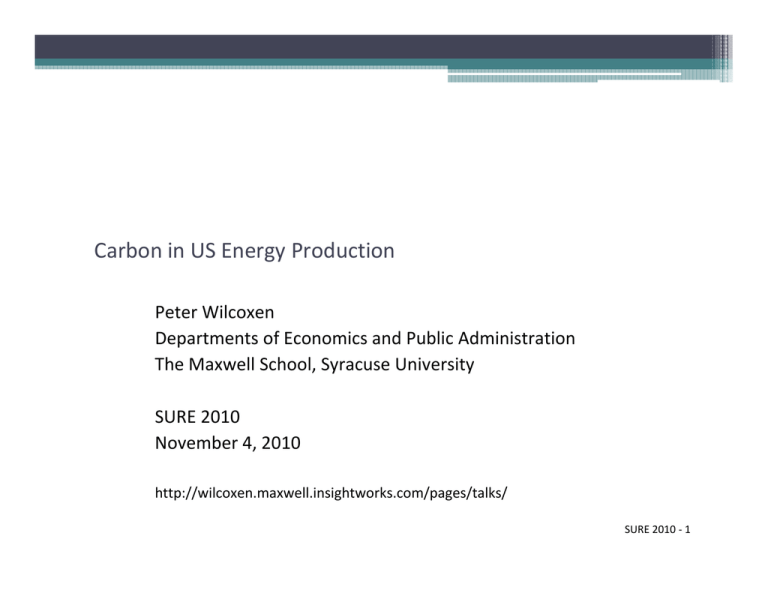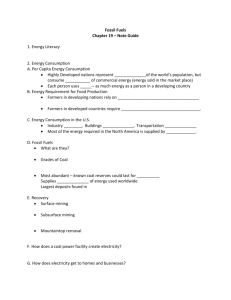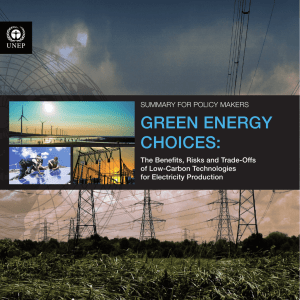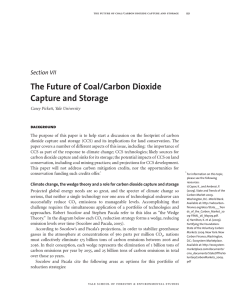Carbon in US Energy Production gy
advertisement

Carbon in US Energy Production gy Peter Wilcoxen D Departments of Economics and Public Administration t t fE i d P bli Ad i i t ti The Maxwell School, Syracuse University SURE 2010 November 4, 2010 http://wilcoxen.maxwell.insightworks.com/pages/talks/ SURE 2010 ‐ 1 Fuel use and energy units l d i • National fuel use is measured in quads ▫ 1 quad = 1 quadrillion BTU (10^15) • How large is a quad? ▫ Coal “unit trains”: 100 cars, about 1 mile long ▫ 1 train fuels a 300 MW power plant for about 3 days ▫ 1 quad = 4,500 unit trains SURE 2010 ‐ 2 SURE 2010 ‐ 3 Translating energy into CO2 l i i • Fuels differ in carbon intensity 120 ▫ CO2 produced per quad ▫ Petroleum Ø 23% ▫ Natural gas Ø 44% MMT C CO2 per Quad • Relative to coal: 100 95 73 80 53 60 40 20 0 Coal Oil Gas SURE 2010 ‐ 4 Emissions in million metric tons of carbon (mmt C). Convert to tons of CO2 by multiplying by 44/12. Dark blue flows: emissions from power plants. Attributed to end uses in proportion to electricity consumption. SURE 2010 ‐ 5 Electricity growth has been particularly strong ... l i i hh b i l l 0 10 20 30 40 US Primary Energy Consumption y gy p 1950 1960 Residential Industrial 1970 1980 year 1990 Commercial Transportation 2000 2010 Electricity SURE 2010 ‐ 6 ... especially as a share of the total i ll h f h l 0 Percent of Totall 10 20 30 40 Composition of US Primary Energy Consumption p y gy p 1950 1960 Residential Industrial 1970 1980 year 1990 Commercial Transportation 2000 2010 Electricity SURE 2010 ‐ 7 SURE 2010 ‐ 8 California load curve lif i l d • Independent System Operator (ISO) ▫ Operates part of the electrical grid • Data for January 21, 2008 • Demand (red curve): ▫ Min at 3:30 am, 21 GW , ▫ Max at 6:30 pm, 32.5 GW ▫ Max is 55% higher • Capacity (green curve): ▫ 34.5–41 GW SURE 2010 ‐ 9 Types of plants f l • Base load ▫ Run almost all the time ▫ Expensive to build, slow start, cheap to run Coal nuclear ▫ Coal, nuclear • Peaking ▫ Run during peak periods R d i k i d ▫ Cheap to build, quick start, expensive to run ▫ Gas, oil, hydro • Intermittent ▫ Weather dependent: wind, solar p SURE 2010 ‐ 10 Oil 12% of capacity 50 GWyr Natural Gas 22% of capacity 290 GWyr 7 GWyr Electric Sector Capacity Utilization 2006 84 GWyr Coal 72% of capacity 84 GWyr 511 GWyr y 224 GWyr Nuclear 90% of capacity 10 GWyr GW r Renewables R bl 34% of capacity 77 GWyr 90 GWyr 39 GWyr 955 GWyr GW r 444 GWyr Legend Electricity, GWyr [GWyr] Additional Capacity, GWyr [GWyr] SURE 2010 ‐ 11 When were plants built? h l b il ? SURE 2010 ‐ 12 Potential gains from fuel switching i l i f f l i hi • Carbon intensity of fuels 12 1.2 ▫ Gas: 44% less CO2 per quad ▫ Pulverized coal ≈ 34% ▫ Combined cycle gas ≈ 46% • CO2 per MWh relative to coal: ▫ Natural gas Ø 57% MT CO O2 per MW Wh • Efficiency in generation 1 0.94 0.8 0.6 0.40 0.4 0.2 0 Coal CC Gas SURE 2010 ‐ 13 Leading options for replacing fossil di i f l i f il • Integrated gasification combined cycle coal (IGCC) g g y ( ) ▫ With carbon capture and sequestration (CCS) • Combined cycle gas Combined cycle gas ▫ With CCS • Nuclear l • Renewables SURE 2010 ‐ 14 Replacing fossil completely? l i f il l l ? • Need about 550 GW to eliminate fossil ▫ 330 GW base load ▫ 220 GW peaking • Fossil with CCS ▫ 410 GW of IGCC CCS coal (80% utilization) = $1.4 T ▫ Add CCS to 220 GW of combined cycle gas = $220 B Add CCS t 220 GW f bi d l $220 B x Total = $1.6T • Intermittent renewables ▫ 1300 GW of wind (25% utilization) = $2.5 T f y g ▫ Add CCS to 220 GW of combined cycle gas = $220 B x Total = $2.7 T SURE 2010 ‐ 15 Transmission grid i i id • Can we get power where it’s needed? g p • Especially important for wind and solar ▫ Best locations are far from cities B l i f f ii ▫ Need geographic dispersion SURE 2010 ‐ 16 More grid capacity needed for wind id i d df i d Variation in wholesale electricity prices due to grid congestion yp g g From “2006 From 2006 Midwest ISO Midwest ISO‐PJW PJW Coordinated System Plan (CSP), Coordinated System Plan (CSP),” December 2006. December 2006. SURE 2010 ‐ 17 Historical perspective? i i l i ? • Does fuel use rise inexorably no matter what? y • What do we know from history about fuel use? SURE 2010 ‐ 18 0 50 Quadrillion BTU U 100 150 20 00 Exponential growth after the war (3.4%) i l h f h ( %) 1940 1960 Year Actual 1980 2000 Fitted SURE 2010 ‐ 19 0 50 Quadrillion BTU U 100 150 20 00 Sharp change after the energy shocks! h h f h h k! 1940 1960 Year Actual 1980 2000 Fitted SURE 2010 ‐ 20 Energy prices matter! i ! • Stabilized US energy consumption gy p ▫ Flat for about 20 years • GDP growth was a little slower GDP gro th as a little slo er ▫ About 0.2% per year: from 3.2% to 3.0% SURE 2010 ‐ 21 A very large problem ... l bl • Currently: y ▫ 86 quads of fossil fuels ▫ 6 gigatons of CO2 emissions • To limit temperature increase to 2° C: ▫ Need to bring CO2 down by more than 80% • Rough targets by 2050: ▫ 16 fossil quads f q ▫ 1 gigaton CO2 Ø70 quads q Ø 5 gigatons • Will be very difficult without a rise in fossil prices Will be very difficult without a rise in fossil prices SURE 2010 ‐ 22






